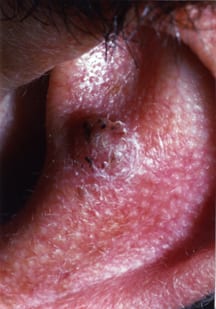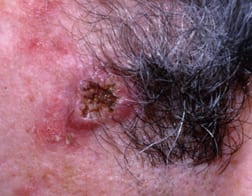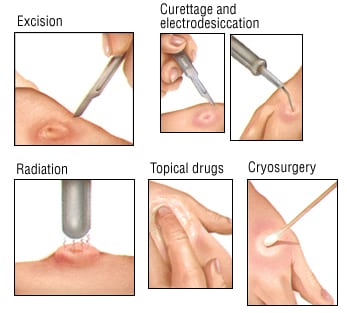Patient Basics: Squamous Cell Carcinoma of the Skin
Originally published by Harvard Health.
What Is It?
Squamous cells are small, flat skin cells in the outer layer of skin. When these cells become cancerous, they typically develop into flat or raised, rounded skin tumors. Sometimes the skin around the tumors gets red and swollen.
Most cases of squamous cell carcinoma occur in people who have spent lots of time in the sun—especially those with fair skin and blue eyes. Some cases develop on skin that has been injured or exposed to cancer-causing agents. This type of squamous cell cancer can develop on:
- Scars, burns, and long-lasting ulcers
- The legs and body of workers exposed to poisons, harsh chemicals, and agents like tar and soot
- Skin affected by genital warts
- Red patches of skin covered with white scales, a condition called psoriasis, treated with certain therapies.
People with a weakened immune system are at especially high risk of developing squamous cell cancer. This includes people who:
- are HIV positive
- have received an organ transplant
- Taking immune-suppressing medications.
When it is found early and removed, squamous cell carcinoma causes little skin damage. But if the cancer is not removed when it’s small, it can leave a scar. In a small number of cases, the cancer spreads to the lymph nodes and other parts of the body. Squamous cell carcinoma is most likely to spread when it is on the lips, ears, or genitals.
Symptoms
Squamous cell skin carcinoma usually appears as a tiny, painless bump or patch. The skin around it can be red and swollen. The cancer itself can be scaly, crusty, or wartlike. It can have an open sore in the center.
Although squamous cell carcinoma can develop on any part of the body, the most common spots are the:
- head, including the scalp, lips, ears, and mouth
- legs
- Back of the hands and the arms.
Diagnosis
Your doctor will examine your skin and may remove a small, abnormal piece to be examined in a laboratory. This procedure is called a biopsy. Occasionally, the doctor will remove the entire abnormal area.
In the laboratory, a pathologist will examine the tissue under a microscope to determine if it is a skin cancer. If so, the pathologist will look at the margins (edges) of the specimen. If cancer remains at the margin, you will need another procedure to remove the rest of the cancer.
Expected Duration
Once squamous cell carcinoma develops on the skin, it usually grows slowly. But if it is neglected and grows to more than 2 centimeters across, it is three times more likely to spread than a smaller cancer.
Prevention
Because squamous cell carcinoma is caused by spending time in the sun, you can take steps to prevent it:
- Apply sunscreen before you go outdoors. Choose one with a sun protection factor (SPF) of at least15. Be sure it protects against both ultraviolet A and ultraviolet B rays.
- Use sunblock on your lips. Choose one made for the lips, with an SPF of at least 20.
- Stay out of the sun when it is strongest. This is between 10 a.m. and 4 p.m.
- Wear sunglasses that protect again ultraviolet light.
- Wear long pants, a shirt with long sleeves, and a wide-brimmed hat.
If you take prescription medications and you spend significant time outdoors, ask your doctor if you need to take any extra precautions. Some drugs increase your risk of skin damage. These include certain antibiotics and medications used to treat mental illness, high blood pressure, heart failure, acne, and allergies. Also, some skin-care products contain alpha-hydroxy acids. These chemicals can make your skin more vulnerable to damage from the sun.
If a squamous cell carcinoma develops on your skin, you can limit the damage by detecting the problem early. To do this, examine your skin thoroughly every month or two. Use a mirror to look at your back, shoulders, and other areas you can’t easily see.
Treatment
There are many ways to treat squamous cell carcinoma that has not spread. These include:
- Cutting away the cancer and a small amount of healthy tissue around it. If a large area of skin is removed, a skin graft may be necessary.
- Scraping away the cancer with a surgical tool. A doctor the uses an electric probe to kill any cancerous cells left behind.
- Freezing cancer cells with a chemical called liquid nitrogen. This treatment usually is reserved for very small tumors. It is also used when a patch of skin looks abnormal but isn’t yet cancerous.
- Destroying the cancer with radiation.
- Shaving away the cancer, one thin layer at a time. Each layer is examined under the microscope as it is removed. This technique helps the doctor preserve as much healthy skin as possible.
- Applying drugs directly to the skin or injecting them into the tumor.
- Using a narrow laser beam to destroy the cancer.
Which treatment is best for you? That depends on many factors, including the size and location of the cancer, whether it has returned after previous treatment, your age, and your general health.
Once your treatment is finished, your doctor will schedule regular follow-up skin exams. He or she may want to see you every three months for the first year, for example, and then less often after that.
When To Call a Professional
Call your primary care doctor or a dermatologist (a doctor who specializes in skin problems) if you notice that you have an abnormal bump or patch on your skin, or if you have a sore that does not heal.
Prognosis
In most cases, the outlook is excellent. Over all, 95% to 98% of squamous cell carcinomas can be cured if they are treated early. Once a squamous cell carcinoma has spread beyond the skin, less than half of patients live five years, even with aggressive treatment.
Additional Information
National Cancer Institute (NCI)
U.S. National Institutes of Health
Public Inquiries Office
6116 Executive Blvd.
Room 3036A
Bethesda, MD 20892-8322
Phone: 301-435-3848
Toll-Free: 1-800-422-6237
TTY: 1-800-332-8615
http://www.nci.nih.gov/
American Cancer Society (ACS)
Toll-Free: 1-800-227-2345
TTY: 1-866-228-4327
http://www.cancer.org/
American Academy of Dermatology
P.O. Box 4014
Schaumburg, IL 60168-4014
Phone: 847-240-1280
Toll-Free: 1-888-462-7546
Fax: 847-240-1859
http://www.aad.org/
The Skin Cancer Foundation
149 Madison Ave.
Suite 901
New York, NY 10016
Phone: 212-725-5176
http://www.skincancer.org/







